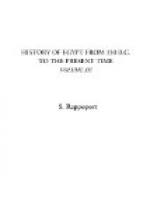It has just been noted that the hieroglyphic inscriptions are by no means restricted to sacred subjects. Nevertheless, the most widely known book of the Egyptians was, as might be expected, one associated with the funeral rites that played so large a part in the thoughts of the dwellers by the Nile. This is the document known as “The Chapters of the Coming-Forth by Day,” or, as it is more commonly interpreted, “The Book of the Dead.” It is a veritable book in scope, inasmuch as the closely written papyrus roll on which it is enscrolled measures sometimes seventy feet in length. It is virtually the Bible of the Egyptians, and, as in the case of the sacred books of other nations, its exact origin is obscure. The earliest known copy is to be found, not on a papyrus roll, but upon the walls of the chamber of the pyramid at Saqqara near Cairo. The discovery of this particular recension of “The Book of the Dead” was made by Lepsius. Its date is 3333 B.C. No one supposes, however, that this date marks the time of the origin of “The Book of the Dead.” On the contrary, it is held by competent authority that the earliest chapters, essentially unmodified, had been in existence at least a thousand years before this, and quite possibly for a much longer time. Numerous copies of this work in whole or in part have been preserved either on the walls of temples, on papyrus rolls, or upon the cases of mummies. These copies are of various epochs, from the fourth millennium B.C., as just mentioned, to the late Roman period, about the fourth century A.D.
Throughout this period of about four thousand years the essential character of the book remained unchanged. It is true that no two copies that have been preserved are exactly identical in all their parts. There are various omissions and repetitions that seem to indicate that the book was not written by any one person or in any one epoch, but that it was originally a set of traditions quite possibly handed down for a long period by word of mouth before being put into writing. In this regard, as in many others, this sacred book of the Egyptians is closely comparable to the sacred books of other nations. It differs, however, in one important regard from these others in that it was never authoritatively pronounced upon and crystallised into a fixed, unalterable shape. From first to last, apparently, the individual scribe was at liberty to omit such portions as he chose, and even to modify somewhat the exact form of expression in making a copy of the sacred book. Even in this regard, however, the anomaly is not so great as might at first sight appear, for it must be recalled that even the sacred books of the Hebrews were not given final and authoritative shape until a period almost exactly coeval with that in which the Egyptian “Book of the Dead” ceased to be used at all.




